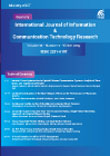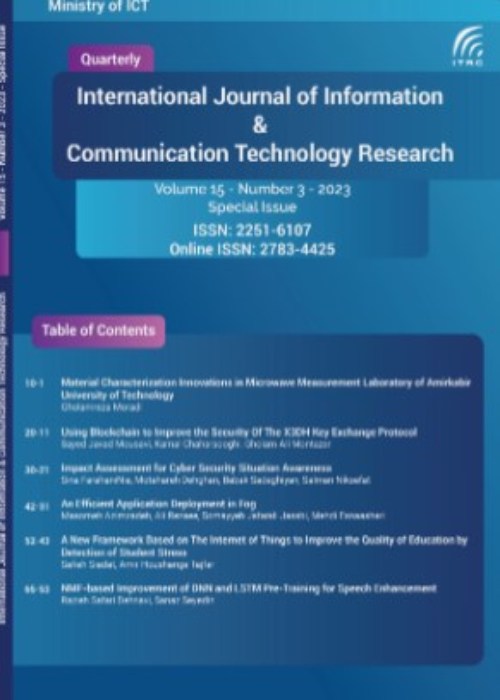فهرست مطالب

International Journal Information and Communication Technology Research
Volume:11 Issue: 1, Winter 2019
- تاریخ انتشار: 1398/11/22
- تعداد عناوین: 7
-
-
Pages 1-11
In this paper, we propose to use discretized version of the so-called Enhanced Gaussian Noise (EGN) model to estimate the non-linearity effects of fiber on the performance of optical coherent and uncompensated transmission (CUT) systems. By computing the power of non-linear interference noise and considering optical amplifier noise, we obtain the signal-to-noise (SNR) ratio and achievable rate of CUT. To allocate power of each CUT channel, we consider two optimization problems with the objectives of maximizing minimum SNR margin and achievable rate. We show that by using the discretized EGN model, the complexity of the introduced optimization problems is reduced compared with the existing optimization problems developed based on the so-called discretized Gaussian Noise (GN) model. In addition, the optimization based on the disctretized EGN model leads to a better SNR and achievable rate. We validate our analytical results with simulations and experimental results. We simulate a five-channel coherent system on OptiSystem software, where a close agreement is observed between optimizations and simulations. Furthermore, we measured SNR of commercial 100Gbps coherent transmitter over 300 km single-mode fiber (SMF) and non-zero dispersion shifted fiber (NZDSF), by considering single-channel and three-channel coherent systems. We observe there are performance gaps between experimental and analytical results, which is mainly due to other sources of noise such as transmitter imperfection noise, thermal noise, and shot noise, in experiments. By including these sources of noise in the analytical model, the gaps between analytical and experimental results are reduced.
Keywords: Optical Coherent Transmission Systems, Fiber Non-linear Interference Noise, Power Allocation, Minimum Signal-to-Noise-Ratio (SNR) Margin, Maximum Achievable Capacity -
Pages 12-18
The two dimensional (2D) plasmon propagation in the channel of a high electron mobility transistor (HEMT) is numerically analyzed using the full wave method. By applying different bias voltages to the drain and the gate terminals, the properties of the 2D plasmons propagation along the channel are investigated. In this analysis, the Maxwell’s equations are solved in conjunction with the hydrodynamic transport equations, using the finite difference time domain (FDTD) technique. The obtained results show that the wavelengths and the propagation constants of the 2D plasmons are considerably affected by varying the bias voltages. Then, by considering these effects, the tunability of a grating gate HEMT detector over terahertz (THz) frequencies is investigated, using the proposed full wave model. Our studies demonstrate that it is possible to control the characteristics of the 2D plasmon propagation along the channel by changing the bias voltages to produce various types of reconfigurable structures used for THz applications.
Keywords: component, 2DEG channel, 2D plasmon, full wave model, hydrodynamic equations, HEMT structure, resonant detector -
Pages 19-26
In recent years, researchers have introduced many different mechanisms to improve resource allocation in the cloud. One of these resource allocation methods is market-based resource allocation which exploits different models used in exchanging goods and services. In this research, a two-way auction model is used for allocating cloud resources based on the market model. In the case of federated clouds, as the providers may face a shortage of resources during their operation; therefore, the continuous double auction model is suggested to create a cloud federation environment to support a suitable resource allocation among different providers. In our experiment 1, fixed pricing with Reputation-Aware Continuous Double Auction, Continuous Double Auction, and Market-Driven Continuous Double Auction models will be executed for resource allocation. It shows that both the resource efficiency and the income of the providers are improved in the federated clouds using these models. In experiment 2, with changing the type and number of the requested resources by customers and providers, the proposed federated model is also tested. The results of the experiments show that our proposed model for implementing federated clouds based on the continuous double auction model, in terms of successful allocation rates, resource efficiency and provider revenue, is better than other market-oriented models.
Keywords: Resource allocation, Cloud federation, Continuous double auction, Double Auction model -
Pages 27-35
Semantic relations between words like synsets are used in automatic ontology production which is a strong tool in many NLP tasks. Synset extraction is usually dependent on other languages and resources using techniques such as mapping or translation. In our proposed method, synsets are extracted merely from text and corpora. This frees us from the need for special resources including Word-Nets or dictionaries. The representation model for words of corpus is based on Vector Space model and the most similar words to each are extracted based on common features count (CFC) using a modified cosine similarity measure. Furthermore, a graph-based soft clustering approach is applied to create clusters of synonymous words.To examine performance of the proposed method, Extracted synsets were compared to other Persian semantic resources. Results show an accuracy of 80.25%, which indicates improvement in comparison to the 69.5% accuracy of pure clustering by committee method.
Keywords: Automatic Synset Extraction, Semantic Relation, Graph-based Clustering, CBC clustering, Persian -
Pages 36-44
Sequential pattern mining is an interesting data mining problem with many real-world applications. Though new applications introduce a new form of data called data stream, no study has been reported on mining sequential patterns from the quantitative data stream. This paper presents a novel algorithm, for mining quantitative streams. The proposed algorithm can mine exact set of fuzzy sequential patterns in sliding window and gap constraints entailing the most recent transactions in a data stream. In addition, the proposed algorithm can also mine non-quantitative or transaction-based sequential patterns over a data stream. Numerical results show the running time and the memory usage of the proposed algorithm in the case of quantitative and customer-transaction-based sequence counting are proportional to the size of the sliding window and gap constraints.
Keywords: Data Stream, Fuzzy Sequential Pattern Mining, Gap Constraint, Sliding Window -
Pages 45-56
As an extension of classical ontology, a fuzzy ontology by employing fuzzy set theory can easily and yet better deal with uncertainties especially for the cases in which knowledge is vague. Obviously, fuzzification plays an important role in each fuzzy ontology. The main goal of this paper is to present an RDF based ontology, which indeed should contain many facts about the real world, inevitably facing with some uncertainties. In this perspective, an RDF based ontology is converted into a fuzzy most probably an incomplete one due to the fact that there will be some missing relations in the converted fuzzy ontology. To remedy this, the paper introduces a new method in the general framework of conversion and completion of an RDF based ontology into a fuzzy ontology mainly using the facts aspect. Therefore, first a new definition of the fuzzy ontology is proposed. To do so, a neural tensor network, which is indeed state-of-the-art of RDF based ontology completion, is proposed. Furthermore, a new application is suggested for this network that can create a fuzzy ontology. To furnish this goal, two new algorithms are then introduced for the conversion and completion of the proposed fuzzy ontology. In the proposed method, ontology facts are first embedded in a vector space, and then a score value is given to each fact by a learning method. Using these scores and threshold values of each relation, ontology facts can be fuzzified. Finally, some simulation studies are conducted to evaluate better the merit of the proposed method.
Keywords: Ontology, Fuzzy Ontology, Facts, Neural Tensor Network, RDF -
Pages 57-70
Nowadays growing threat and security risks in information and communication technology and also increasing use of information and communication technologies are two main decision makers for organizations, service providers and the general public. Resource limitation and the lack of expert in cyber security have made lots of major challenge for different service providers in dealing with and managing security threats. In many developing countries, this problem has been solved using Managed Security Service Providers. Managed Security Services are network-based security services that are outsourced by a trusted third party. The diversity of Managed Security Service Providers affects the effectiveness and efficiency of decision making in this area. Therefore, in order to outsource the security services, the assessment of these organizations is inevitable. This assessment can be done by various mechanisms. One of the acceptable strategies in the security is the maturity model. Maturity models are step-by-step solutions to grow organizational capabilities Along with a predicted, desirable, and logical path. In fact, maturity models provide standard way to assess process maturity along with business process improvement. Until now, no maturity model has been developed to assess the Managed Security Service Providers. Therefore, in this paper, we have proposed a novel model to external evaluation of the Managed Security Service Providers based on maturity model. The evaluation of the proposed maturity model is based on multiple case studies. We have optimized our proposed model by using these case studies in three different MSSPs.
Keywords: Maturity model, MSSPs, Assessment, maturity factors, Security maturity


